
5 Things to Know about Thailand Music Market with Somwalee Limrachtamorn

In 2013, only 33.4% of Thai citizens used the Internet. By 2023, thanks to a massive digitization policy, 85.3% of the country's 71 million inhabitants were accessing it daily. Still in 2023, 50% of Thai Internet users aged 16 to 64 indicated that listening to music was one of their main reasons for using the Internet1
Even though 11% of Thailand's population is estimated to live in the capital city Bangkok2 – with a total urban population of 53.6% – the rest of the country isn’t lagging behind, as it’s one of the 10 countries with the best fixed broadband in the world. Moreover, Thai Internet users are ultra-connected: 98.1% of them have a smartphone, and they spend an average of almost 8 hours a day on the Internet, including 1.49 hours listening to music streaming services1.
Added together, all this data explains the strong growth in streaming revenues in Thailand over the last 10 years. So much so that, according to IFPI3, the Land of Smiles was the world's 24th-largest market for recorded music in 2022, reaching $105.4 million in revenues, 90.8% of which were generated by streaming.
To gain an insight into this exciting yet still little-known market, we spoke to Somwalee Limrachtamorn, Country Manager for Thailand at Believe, about the current state of the Thai music business and its most striking features.
In recent years, the music market in Southeast Asia, and Thailand in particular, has been attracting a great deal of interest. Does this newfound attention indicate that the market has shifted?
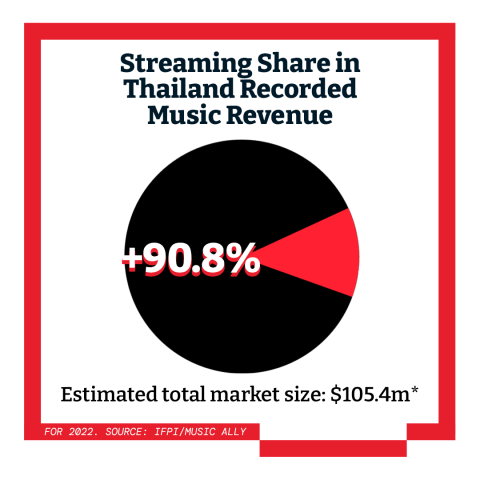
The Thai music market has indeed expanded in the past ten years, most notably music streaming during the COVID period. COVID was perhaps one of the biggest accelerators of Thailand’s music digital business. Since this period, we have seen a much larger contribution of digital music streaming to the total recorded music revenue.
Before, non-digital music sales could represent 80% up to 90% of a record label’s revenue. When the music market plummeted because the country came to a standstill during COVID, record labels started to put more focus and resources into digital. As of 2023, most independent Thai record companies have set themselves the target of increasing revenue from digital activities to around 50%. This underlines the significance and boldness of their strategic plans.
Over the last ten years, there has been an acceleration in the country’s urbanization – outside Bangkok too, as the government’s plan is to expand infrastructures into capital cities in every region – which paired with a strong digitization. Thailand now has the 6th best broadband Internet connection globally, and one of the best Wi-Fi infrastructures in ASEAN.
This is connected to the widespread use of social media in Thailand: about 85% of Thai internet users are on social media. ByteDance even recently claimed that nearly 50% of Thai social media users were using TikTok5. It gives you an idea of how important social media use is here. And it also illustrates how independent artists and labels are taking up on digital to generate digital revenue.
Thanks to digitization, these independent labels are now the one driving growth in the local market. I’m going back over the history of the Thai music industry, but about twenty years ago, you would only find large local major labels. Independent newcomers started appearing in the last decade - coincidentally around the time Believe settled in Thailand too. Thailand also now has more experienced independent artists, well-versed in digital tools and marketing, and we expect them to play a more significant role in the market's future contributions.
Finally,most of music streaming is done through free or freemium services and apps here. But looking at the data, there’s a clear evolution: audio premium is growing much faster than anything else.
Converting users from free to premium is obviously most of the DSPs' priority. While audio platforms have chosen to focus on attracting premium users, video platforms are adopting different strategies to retain users, such as working with artists to attract and engage their fans
A DataReportal study1 on Thai digital habits reveals that 50.1% of users use the Internet mainly for listening to music. However, when comparing weekly audio and video content consumption, 36.9% opt for streaming music, while 56% prefer watching music videos. Does this suggest that video primarily drives the streaming market in Thailand, and if so, how do streaming audio platforms position themselves accordingly?
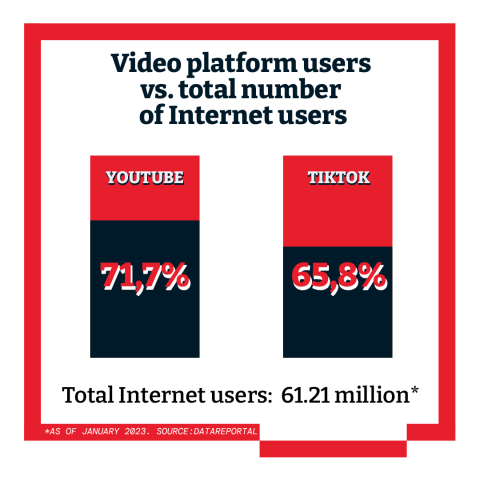
I don't know how much it's related, but Thai people tend to be more visual in the way they consume media. What is sure, however, is that Thailand’s music streaming market is essentially video-based, and it’s mainly driven by YouTube. Moreover, Thai consumption of short-form videos is exceptionally high. Meta is also growing fast on the video platform market too.
Audio-wise, I would say that Spotify and Apple are coming up and focusing on more premium segments. Other DSPs include local player Plern, and regional DSP Joox, well known in Thailand, thanks to effective marketing campaigns. But most of audio streaming is done on international DSPs.
Their audience is mainly located in the capital and at the top end of the market. They tend to focus more on pop and indie pop, two genres whose audiences are more urbanized and more inclined to pay for premium. They are also developing playlist for Thai hip-hop, which has a primarily Bangkok-based audience but is spreading to other cities, as well as in neighboring countries like Laos, Cambodia and Myanmar. Video platforms on the other hand are used everywhere in Thailand. And even if they cover all genres, when you look at YouTube’s top chart, you will also see hip-hop, although it comes second after Thai country music.
Converting users from free to premium is obviously most of the DSPs' priority. While audio platforms have chosen to focus on attracting premium users, video platforms are adopting different strategies to retain users, such as working with artists to attract and engage their fans or establishing partnerships with local TelCos.
Although still a video-centric market, Thailand is now on the path to become premium market thanks to radical change in usage behavior, we're seeing a steady migration to audio platforms, particularly through subscriptions.
We interviewed independent hip-hop artist Saran in 2023, and the fact that he was the 3rd most streamed Thai artist on YouTube in 2022 clearly shows that hip-hop is one of the hottest genres in Thailand right now. What explains this hype? And what other genres are currently popular?
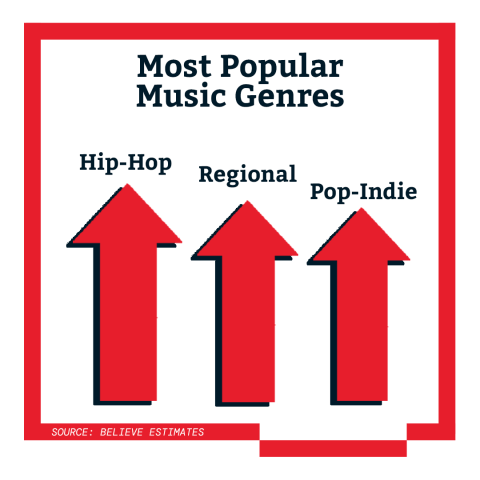
The most popular genres in Thailand right now are pop (including indie pop and T-Pop), hip hop and regional music. The last two genres are also very viral on TikTok, which can also explain these trends.
Hip-hop is a widespread musical genre here, and the growth in its listening is partly linked to the growing Gen Z population. Representing almost 20% of the population, Gen Z is now the dominant audience in Thailand across all genres, but it has a special interest in hip-hop. Also, a distinction should be made between “underground hip-hop” and “mainstream hip-hop”, the latter being more “commercial”, pop-oriented with “light” lyrics. It was what was dominant 20 years ago, rapper and singer URBOYTJ is a good example of the genre. Saran falls into the "underground hip-hop" category, which can be broken down into different sub-genres.
Hip-hop is gaining so much ground that Believe has launched bYOND, a local label dedicated to up-and-coming artists in the genre. It has very strong connections with the local scene, notably with Rap Is Now, the most famous hip-hop community in Thailand. We are also working with another growing community called Warp Gang. bYOND expects to develop more hip-hop artists over the coming years as the genre keeps expanding.
Regional music is the genre that has been growing the most lately. Modern regional music differs slightly from the older Thai country music, like Luk Thung and Mor Lam, by being more “pop”, while sharing many characteristics in melodies and lyrics. Its audience is Gen Z too, but mostly located outside Bangkok.
It also has the largest and most widespread audience: it encompasses Bangkok's central region’s 15 million population and extends to the 22 million population of North Eastern Region (or Isan region), even reaching the 6 million music consumers in Laos. Additionally, the Isan and Lao diaspora listeners who migrated to more mature markets, like the US or Australia, constitute another strong listenership for Thai regional music.
We are convinced that the regional pop genre will grow bigger in the future. Firstly, because of the growing young audience outside Bangkok. And secondly, because when I talk to labels and indie-pop or hip-hop artists, they all express their interest in collaborating with regional pop artists. It has a huge potential audience, and the result of mixing genres can be very exotic and attractive, so it's easy to create hype around this.
One last word about Thai Pop. It’s the genre that exports the most, thanks to Boy's Love culture (“BL” for short). If you're not familiar with this, Thailand’s BL Culture is mostly television dramas aimed at a female audience and revolving around love stories between men, and it features a lot of Thai pop music. It has grown very popular regionally and globally in the past ten years. It exports well in China, but there is also a growing audience in the Americas or Europe. Spotify even makes special Boy's Love playlist for fans around the world6. And much like K-Pop, T-Pop creates fandoms with very dedicated fans who'll support their idol on whatever they do.
Whatever the size of the digital music market in the future - and it could account for up to 30% of total music industry revenues - the rest will ultimately come from live music and brand partnerships.
According to specialists7, there's a growing demand for live music in the region. What is the situation in Thailand, and how is the local live music market structured in this respect? Do local artists benefit from this public demand for shows?
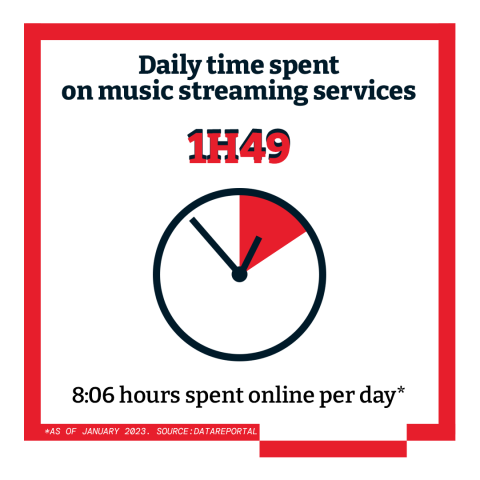
Live music has always been large in terms of music revenues in Thailand, much larger than anything else. Whatever the size of the digital music market in the future - and it could account for up to 30% of total music industry revenues - the rest will ultimately come from live music and brand partnerships. We usually associate live music revenues with brand partnerships, because it usually goes hand in hand here.
Most live music income doesn’t come from concerts or festivals here, but from pub shows and live music bars. It generates a large amount of money, especially for local major labels. To better understand, consider that some well-known artists can have up to 20 to 30 gigs a month.
However, there are a lot of music festivals in Thailand, and it's a sector that's set to grow, as the Thai government is promoting a shift to "experience economy" (i.e. an economy that emphasizes on creating memorable consumer experiences to enhance economic value8) to attract tourism and stimulate the service industry, and music festivals are one of the sectors identified for development. And there’s also an important demand from domestic Gen Z audience.
The key thing is that live music plays two roles, and this is an argument concert promoter put forward. For artists like Saran, who focus on streaming to grow their career and reach their fans, live music can help them expand their audience when they reach their audience ceiling. So doing concerts and festivals can help them get discovered by new fans and access new revenues – which is obviously crucial for artists who essentially are entertainers, such as TimeThai. Even if he has good streaming numbers, he relies more on live performances.
So not only do live and streaming have an important complementary role in the Thai music industry, they also allow artists to freely choose what suits them best, while offering them more revenue and growth opportunities.
While this exists in every country's music industry, the business of artist-brand partnerships seems to be highly developed in Thailand, where it is common to see top artists in commercials, and where some label websites highlight their artists' presence in marketing campaigns. How important is this phenomenon for the local music industry and artists' careers?
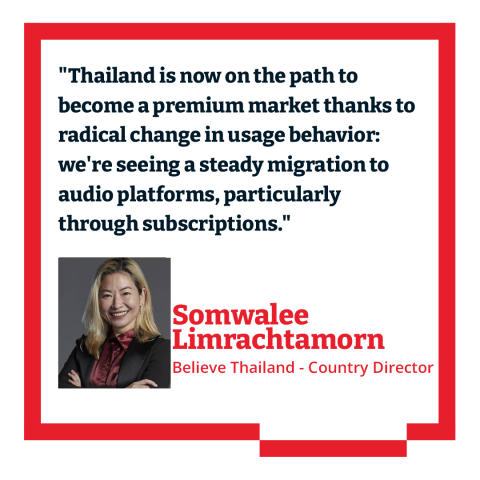
If you look at the overall sales of the music industry in the US or Australia, recorded music accounts for around three-quarters or two-thirds of the industry's total sales, then it is live music revenues, and a small part comes from brand partnerships. Thailand is on the flip side: live music and partnerships currently account for the lion's share of revenues.
If you come to Thailand, you'll see a lot of ads, product placements or event sponsorships with music artists. Because, as elsewhere, the retail market has become so important that brands are turning to influence marketing to promote their products and services. And music artists are considered influencers on the same level as actors, gamers, and YouTubers. Brand partnerships obviously existed before, but it has significantly developed over the last ten years, along the market’s digitization and the arrival of Gen Z. It’s precisely Gen Z consumers that advertisers and brands want to reach through artists that will represent and promote them.
Record companies can’t neglect this, as it can represent fantastic margins for them. And being able to secure good partnerships can also be a way to retain their top artists. In fact, most record companies include brand partnerships in their artist contracts nowadays. It can be very advantageous for independent artists and labels, as they can capture a smaller, more specific audience, which is more interesting for advertisers.
On the artists' side, not only are they going to see a significant incoming from the brand partnership deal, but they will consider it a sign of their success, that they're becoming bigger. So, it is quite common for artists to do these types of partnerships.

A strong believer in engagement and people empowerment, Somwalee Limrachtamorn has been Believe's Country Manager for Thailand since February 2022.
Somwalee previously held the position of Managing Director for Thailand at data analytics company Nielsen. Throughout her 18-year career there, she has consolidated her experience in a wide range of sectors, including FMCG retail, automotive, finance/banking, telecoms, media and entertainment. She’s a graduate of Thammasat University, where she earned a Master's Degree in Economics. The Believe teams she leads will be key in driving the growth of local acts, rising alongside the boom in the SEA music market.
Sources
1. Source: Digital 2023: Thailand — DataReportal – Global Digital Insights
2. Source: Thailand - The World Factbook (cia.gov)
3. Source: UMG expands in Thailand by buying 70% of RS Group catalogue - Music Ally
4. Source: Speedtest Global Index – Internet Speed around the world – Speedtest Global Index
5. Source: With nearly half its population on TikTok, Thailand ranks top in the platform’s user penetration (daoinsights.com)
6. Source: How Fans Are Inspiring the New Global Growth of Thai Pop and Boys’ Love — Spotify
7. Source: The Rise of the Live Music Industry in Southeast Asia | FULCRUM
8. Source: Welcome to the Experience Economy (hbr.org)

